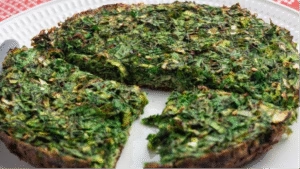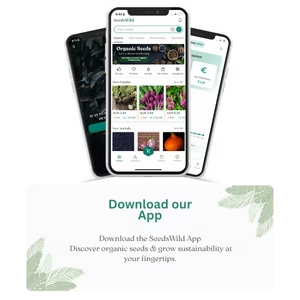Introduction – Edible Nettle, weed or hidden treasure?
“What stung you yesterday could become your ally tomorrow. Nettle is a paradox: unloved and feared, yet also a superfood and organic fertilizer. This guide shows you how to turn a prickly weed into a valuable resource, both in the kitchen and in the garden.”
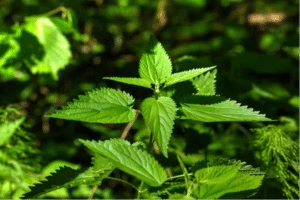
Why nettle deserves a place in your kitchen and garden
We fear its stings… but nettle (Urtica dioica) is far more than a “weed.” It’s a super-plant that feeds, heals, and fertilizes. In wild cuisine, it transforms into soup, pesto, or omelet rich in nutrients. In the garden, it becomes a formidable organic fertilizer through nettle tea. In short, nettle has two lives: the one that stings… and the one that nourishes.
🔗 Tela Botanica – Botanical profile of nettle / Université Lorraine – Multi-valorization of nettle.
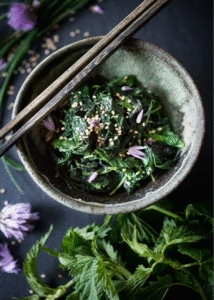
Nutritional benefits of nettle
A true vitality booster, nettle contains more protein than most leafy greens, as well as exceptional amounts of iron, calcium, magnesium, and vitamins (A, C, K). Its polyphenols and carotenoids make it a powerful natural antioxidant. Eating nettle means boosting your energy and immunity while rediscovering a local, sustainable resource.
🔗 Molecules Journal – Nutritional composition of stinging nettle.
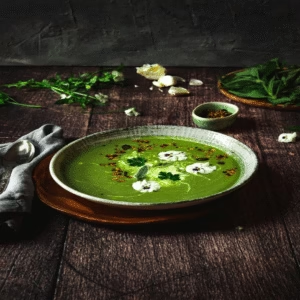
Nettle in herbal medicine: uses and limits
In herbal medicine, nettle is valued for its anti-inflammatory, diuretic, and remineralizing properties. It supports vitality and sometimes relieves joint pain. But caution: nettle may interact with certain treatments (anticoagulants, antidiabetics, antihypertensives). It is therefore a complementary ally, to be used with discernment, never as a substitute for medical treatment.
🔗 NIH – Stinging nettle review.
Harvesting and preparing nettle in wild cuisine
Harvesting nettle is a way to reconnect with an ancestral practice. It grows abundantly in rich soils, but the secret lies in how to pick it and what precautions to take to turn a sting into a gastronomic delight.
🔗 France Inter – How to harvest nettle.
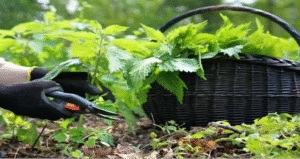
When and how to harvest nettle safely
The best time is spring, when young leaves are tender and nutrient-rich. Pick only the top 15–20 cm using gloves and shears. Avoid roadside or treated areas. Above all: respect the “never more than one-third” rule to allow the plant and insects that depend on it to thrive.
Precautions and contraindications
- Always cook, dry or crush before eating, to neutralize the stinging hairs.
- Do not harvest in full bloom: leaves become fibrous and less digestible.
- Caution for people under medical treatment (possible interactions).
- Prefer occasional use or seasonal cures, as with all medicinal plants.
Easy nettle recipes: soup, pesto, omelet
-
- Nettle soup: blanch leaves, mix with potato and onion for a velvety soup.
- Nettle pesto: replace basil with blanched nettle, blended with garlic, nuts, and olive oil.
- Nettle omelet: add a handful of chopped leaves to beaten eggs for a subtle green flavor.
🔗 Passeport Santé – Nettle recipes.
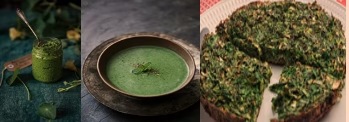
Nettle fertilizer: an essential organic ally
In the garden or on a balcony, nettle fertilizer (nettle tea) is a true ally. Used for generations, it acts as a natural fertilizer rich in nitrogen and minerals, stimulating plant growth and strengthening defenses against pests. Its effectiveness comes from the fermentation of nettle leaves, which releases nutrients and makes them directly available to plants.
Traditional recipe step by step
Making your own nettle tea is simple and economical:
-
- Harvest 1 kg of fresh nettle leaves (before flowering).
- Chop them roughly and place in a non-metallic container.
- Add 10 liters of rainwater (or dechlorinated water).
- Cover partially (allow air circulation) and stir every 2–3 days.
- Let ferment 7 to 15 days, until bubbles stop forming.
- Strain carefully → you get a brown liquid: your fertilizer is ready!
Storage: only a few weeks, in a closed container kept in the dark.
👉 SeedsWild tip: the smell is very strong and may discourage urban gardeners. If you want the benefits of nettle fertilizer without the wait or hassle, discover our organic nettle fertilizer, 1 L ready-to-use for balcony and garden. Easy to store, concentrated, and as effective as homemade → [View the product].
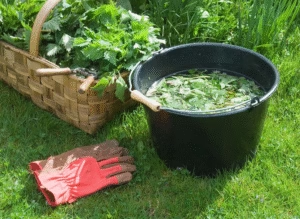
How to dilute and use nettle fertilizer in the garden
“Nettle changes costume in the garden. It becomes one of the most effective and widely used organic fertilizers.”
- Watering at the base → dilute 1:8 to 1:10, once per week.
- Foliar spray → dilute 1:10, as prevention against aphids and diseases.
Tip: apply in the morning or evening to avoid leaf burn.
🔗 Gamm Vert – Using nettle fertilizer.
🔗 Gamm Vert – Using other fertilizer.
Limits and precautions
- Used pure, it can burn roots.
- Legumes (peas, beans, broad beans) don’t need it.
- Short shelf life (a few weeks).
- Strong odor → prepare outdoors!
France-Serres – Nettle fertilizer recipe.
Nettle in permaculture: fertilization and biodiversity
In permaculture, every plant has a function. Nettle feeds, protects, and shelters insects. It’s a bridge between human food and soil fertility.
Nettle also helps raise compost temperature quickly. Rich in organic matter, nitrogen, and bacteria,nettle fertilizer stimulates decomposition and microbial life. It is an endless, renewable, free and non-polluting source of fertilizer.
It can be used throughout the growing season as an insecticide, fungicide, or biostimulant (foliar spray).
Permaculture Design – Natural fertilizer recipes.
Nettle fertilizer vs compost: complementary roles
- Compost = background effect, nourishes soil long-term.
- Nettle fertilizer = immediate effect, stimulates growth.
Used together, they form a complete cycle: nutrient reserve + growth boost.
Pairing nettle with other natural fertilizers
- Comfrey tea → promotes flowering and fruiting.
- Horsetail decoction → strengthens defenses against fungal diseases.
- Vermicompost → balances soil biology.
🔗 Permaculture Design – Purins and natural preparations
FAQ – Everything you need to know about nettle and its fertilizer
Q1. Can you eat nettle raw?
Yes, if it’s chopped, blended or left to rest (neutralizing stinging hairs). The safest way remains blanching.
Q2. When to harvest nettle for fertilizer?
In spring, before flowering, when leaves are richest in nitrogen.
Q3. Which plants should not be watered with nettle fertilizer?
Vegetables (peas, beans, broad beans) and plants sensitive to nitrogen excess (orchids, cacti, succulents).
Conclusion: from wild nettle to organic fertilizer
Summary: cooking, health and natural fertilization
Nettle is a multi-faceted plant: a wild super-vegetable in the kitchen, a health ally in herbal medicine, and a powerful organic fertilizer in the garden. Nettle reminds us of a simple truth: nature has no waste, only resources. What stings can also feed, protect, and heal.
SeedsWild: the app to integrate edible nettle into your daily life
👉 With SeedsWild, nettle becomes your ally. It’s a key to biodiversity. And SeedsWild is here to help you integrate it step by step into your daily life. 🌱
Our app guides you: wild harvesting, cooking, homemade fertilizer, permaculture pairings. Thanks to our AI, get personalized recommendations based on your climate and balcony. Turn your environment into a biodiversity oasis.
👉 Discover organic aromatic & medicinal seeds
👉 Explore our organic green manures and nettle fertilizers
Bonus: Wild recipes (easy & delicious)
Here are three tried-and-true recipes to turn young nettle shoots into tasty dishes:
- Cold or hot nettle soup (4 servings) Ingredients: 200 g young nettle shoots, 1 medium potato, 1 onion, 1 L vegetable broth, salt, pepper, olive oil.
Preparation: blanch nettle 2 min, sauté onion, add potato cubes, simmer in broth 15 min. Add nettle, cook 2 min, blend. Season, serve with olive oil and toasted seeds.
Tip: keep the blanching water (nutrient-rich) to water your garden once cooled. (Carol’s Vegan Kitchen)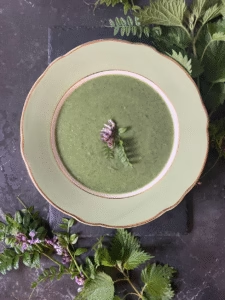
- Nettle pesto (as basil substitute) Ingredients: 50 g blanched nettle leaves, 30 g nuts or pine nuts, 1 garlic clove, 50 g parmesan (or nutritional yeast), 8 cl olive oil, salt.Preparation: blend all ingredients until smooth. Great with pasta, toast, or mixed into plant-based yogurt.
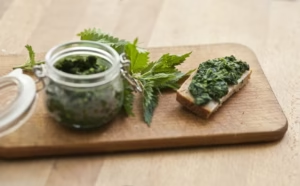
- “Wild” nettle omelet Blanch 50–80 g nettle leaves, drain, press. Beat 3 eggs, add nettle, season, cook gently. Serve warm with salad.
